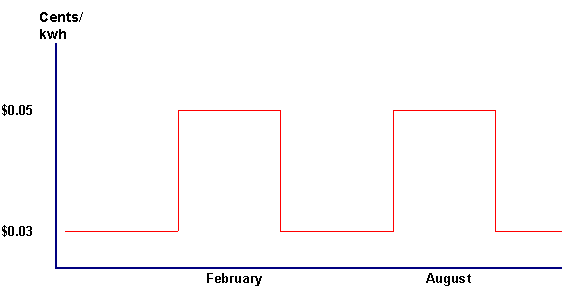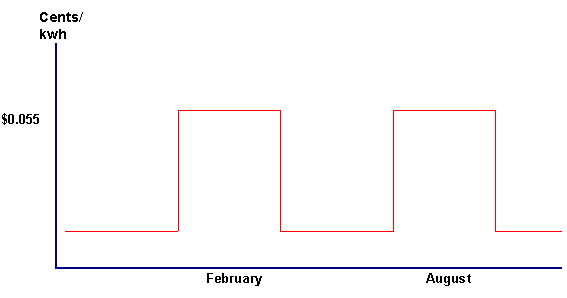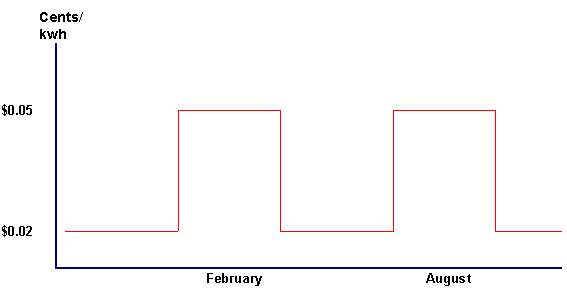 

|
WHY USE POWER
MARKETERS? The Paradox of Saving Money by Paying
Intermediaries for Power Supplies
by Scott Spiewak
(originally published by PMA OnLine Magazine: 04/98)
The electric power industry is becoming more complex. Two decades ago,
there were no real choices for the electric power purchaser. You were served by the local
utility at a price which guaranteed them a reasonable return on their investment.
This began to change with PURPA, and the advent of the IPP industry. By the
mid-1980’s wholesale customers and large retail customers had the additional option
of greenfield development of a new power plant, and falling natural gas prices made that
option a competitive one.
Then in 1992, the Energy Policy Act was passed, and transmission access for wholesale
customers became a right. FERC’s pro forma tariff requirements under the Mega-NOPR
promise to make that right practicably accessible on a broad scale for wholesale
customers.
An increasing number of retail customers are also obtaining access to the open market,
giving them choices in suppliers of electric power, just as they have a choice of
suppliers for virtually every other product they purchase.
Now a new category of company, the "Independent Power Marketer," is offering to
become an intermediary between the buyer and the seller, and promising to reduce prices
even while making a profit on the transaction.
This appears to be impossible, but as I will demonstrate, it is quite natural and on
reflection rather obvious. It explains why marketers have such an important role in other
commodity markets.
How Marketers Save the Customer Money
Advantage 1: No assets to protect
The first advantage of a marketer is that it lacks generation assets. This is important
because it doesn’t have to favor those assets. To illustrate this advantage, I will
hypothesize a competitive bid involving two utilities and an independent power marketer.
Utility one makes an offer based upon its cost of production, which looks like this:
Production Costs: Utility 1

Utility 1 has peak production costs of 5¢/kWh, and off-peak production costs of 3¢/kWh.
It can therefore offer the customer a rate of slightly more than 4¢/kWh on average to
cover its costs and make a profit. (For our purposes I have defined peak and off-peak
periods as the highest cost and lowest cost half of each year).
Utility two makes an offer based upon its cost of production, which looks like this:
Production Costs: Utility 2

Utility 2 has peak production costs of 5.5¢/kWH, but its off-peak production costs are
only 2¢/kWh. It can therefore offer the customer a rate of slightly more than 3.75¢/kWh,
to cover its costs and make a profit.
In a utility-only world, the buyer selects Utility 2.
However, we are no longer in a utility-only world. Now we have marketers to act as
intermediaries. And the marketer combines the best parts of each utility’s offering.
Production Costs: Marketer

The marketer will combine Utility 1’s peak prices with Utility 2’s off-peak
prices to delivery a rate of only 3.5¢/kWh, beating the offer of either utility standing
alone.
This is obviously a simplified example of what a marketer does. The key point is that by
virtue of the fact that the marketer is not tied to any set of assets, it is free to pick
and choose, combining one utility’s output one day, and another utility’s output
the next, to get the best deal possible.
Advantage 2: Risk Management
As we move toward a commoditized electric power market, consumers will increasingly demand
something which has been in short supply in the power business: Prices.
Utilities have traditionally offered cost-based service. If their costs vary, so does the
bill. In soliciting for power supplies, utilities will rarely even quote a price, except
perhaps in the form of a demand charge to reserve the right to certain generation
capacity. The customer pays actual costs incurred plus a profit.
This makes it difficult to compare suppliers, much less establish a budget.
However, there is a reason for this. Utilities receive a regulated rate of return on their
investment. This means that they are entitled to charge their ratepayers for their costs,
and receive a return on their investments. If costs change, prices must change to protect
that regulated rate of return. This is why utilities typically charge their customers with
a "demand " charge, which provides the return on fixed investment, and an
"energy" charge, reflecting operating costs.
Marketer, on the other hand, can give real prices. In response to a request for bids, they
can deviate from the traditional cost-plus rate design and offer a dollar figure.
This not only lends itself to easier comparison among marketers, but also permits the
electricity purchaser to establish a budget for its electricity purchases -- something
which is taken for granted with other commodities.
Interestingly, marketers are able to provide risk management services even for retail
customers who as of yet remain captive to local monopolies. Through use of electric rate
swaps, marketers are revising local tariffs for discrete customers, providing customized
rates linked to the customers products, such as refined oil products, aluminum, natural
electricity and orange juice. Customers whose utility-suppliers are heavily dependent upon
oil or electricity-fired generation have become able to fix their rates to protect them
from the vagaries of their utility’s pricing policies.
These risk management offerings are created using the so-called derivative products:
• options,
• swaps,
• forward contracts, and soon,
• electricity futures.
Risk management is not magic, nor done correctly, is the use of derivative products
inherently risky, regardless of what you might read in the press. In fact, failure to use
derivative products appropriately, as hedges to reduce risk, is considered imprudent.
Luckily, for the electric power customer, risk management and electric power aggregation
need not be a concern. These are the job of the power marketer.
What will I be buying tomorrow?
In the past, a great deal of electric customer attention has been focused on demand side
management, time-of-day rates, power storage, cogeneration and other such measures for
differentiating service. Some of these will remain available, but will be of relatively
little importance in years to come. The reason becomes evident by looking at a graph of
the only index we currently have available for electricity-- the Dow Jones
California-Oregon Border index.
Role of the Electricity Broker
Now that you’ve been introduced to the power marketer, and have an idea of why you
will almost certainly be buying your electricity supplies from a marketer rather than a
power producer, the question arises as to how one selects a power marketer.
The power marketing industry is growing rapidly, with well over 100 companies filed for
marketer status at the FERC. Marketers are continually experimenting with the form of
offers and guarantees to present to their customers, and customers are just beginning to
understand the marketing concept.
However, one fact which is true today, and which will be increasingly true in the future,
is that marketers will have vastly more experience as buyers and sellers of electricity
than their customers-- the producers and consumers of electricity.
An electricity consumer may well enter into only one transaction per year, in which it
locks in its prices for that annual period.
An electricity producer may enter into a transaction considerably less often-- selling all
or a good portion of the life-cycle output of their power plants to marketers before even
breaking ground.
The broker’s role is to represent the customer in its negotiations with the marketer.
Most marketers are not in business to rip off their customers. Particularly at this stage
in the industry’s development, it would be very short-sighted to alienate a customer.
Nevertheless, because the industry is growing and changing quickly, there are choices and
implications to those choices which may not be apparent to the customer faced with a
marketer’s offer. Some of the horror stories include:
Some Things to Watch Out for in Power
Supply Contracts:
Electric supplies which are less than firm.
Your contract will include a clause entitled "force majeure" which excuses
delivery for certain "uncontrollable events." Some suppliers include the
inability to obtain transportation, high prices, or a simple failure to contract for
electricity supplies. Non-firm electricity is cheaper than firm electricity-- but unless
you can stand an interruption in the peak periods, this is not for you.
Short-term electricity supplies.
Your contract may be only for the spring or fall months -- before electricity supplies
become tighter. You will have to pay much more for your electricity after your short-term
contract expires. Insist on a quote for year-round supplies.
Misleading price guarantees.
Your contract may provide an "estimated savings" in the 20% range, with
either no contractual savings guarantee, or a contract which estimates 20%, but only
guarantees 5% savings. Make sure you know the difference between an estimated savings and
a guaranteed savings.
Incorrect payments to the local utility.
Your contract may show estimated savings based upon lower payments for electricity
transportation. Make sure that transportation costs are included in your contract, and not
a pass-through item.
Incorrect electricity usage assumptions.
A calculation which assumes greater electricity usage will necessarily result in
greater dollar savings-- but not a greater percentage saving. Also, estimates which assume
that you use more electricity in the spring and less in the summer will result in lower
prices than you will achieve in reality. Review load factor assumptions in your contract.
Math errors.
Your "estimated savings" may include calculations with overt math errors.
Some contracts are offering "savings of 18%," based upon savings of 11% in 1995
and 7% in 1996. The real savings here is an average of 9%, but unless you carefully review
the calculations, you will not see the math errors.
Fly-by-night companies.
Certification to do business as a power marketer is not an endorsement by the FERC.
Beware companies which may not last out the year. Stick with the brand name companies!
When representing a generator, a broker is a seller’s broker. When representing a
buyer, a broker is a buyer’s broker.
Brokers work on a fee or commission basis. Today, the fees are relatively extravagant.
Buyer’s brokers get about one half mill/kWh for purchases, and upwards of double that
for sales (Consumers are always in short supply. It is relatively more difficult to
successfully sell power than it is to buy it).
As the market becomes more liquid, and the number of transactions increase, brokerage fees
will drop dramatically, as will the margins achieved by power marketers.
Soliciting for Power
In summary, electric power solicitation has changed dramatically. Where once it was simple
rate negotiations with the local utility, with perhaps the fillip of an independent power
plant, today procurement is done using an experienced broker who will increasingly assist
the customer in selecting among power marketers as their suppliers of choice. Of course,
for the power marketer, the procurement of electric power and risk management adjuncts
becomes a much more complicated business, involving a continual hunt for less expensive
generation and transmission paths, and better risk management products. For the broker,
the key job becomes making sure that the marketer’s problems remain just that-- their
problem, and to insulate the customer from the complexities of the marketplace.
Scott Spiewak is Secretary of The Power Marketing Association,
and vice president of business development for CPM Electric & Gas, Inc., an
electricity and natural electricity broker. Mr. Spiewak may be contacted at the following
address:
CPM Electric & Gas, Inc.
3 Fairway Lane
Old Tappan, NJ 07675
Tel. (201) 784-5349; Fax (201) 767-1928
e-mail: spiewak1@soho.ios.com
CPM
ELECTRIC & GAS, INC.
ELECTRIC POWER CONTRACTING & PROCUREMENT
3 FAIRWAY LANE, OLD TAPPAN, NJ 07675
TEL. (201) 784-5349 FAX (201) 767-1928
CPM: The Electric Power Customer’s Broker
The energy market has entered a period of the most profound change in over 75 years. This
change has already started and is affecting both the way energy is sold and services are
delivered. It is anticipated that it will lead to deregulation and a complete
restructuring of the utility industry. It is almost certain that most consumers will be
buying electric power and natural gas from marketers and brokers in the future. The power
marketing industry is growing rapidly, with close to 200 companies filed for marketer
status at the FERC. Marketers are continually experimenting with the form of offers and
guarantees to present to their customers. However, one fact which is true today, and which
will be increasingly true in the future, is that marketers will have vastly more
experience as buyers and sellers of electricity and gas than their customers, the
consumers of these commodities.
For the very sophisticated purchaser, deregulation is likely to bring large reductions in
costs in areas such as the northeast where prices of these commodities are among the
highest in the country. However, very few purchasers have all the expertise required to
take advantage of this situation and most do not have any expertise whatsoever. The major
question for the customer is not only how to select a marketer, but far more important,
how does he correct this technical and commercial imbalance between him and the marketer.
The answer is the retention of a Broker. It is the Broker’s primary role to provide
this expertise and level the playing field between the marketer and the customer. CPM
specializes in the purchase of energy and has developed a purchasing and consultancy
program to meet the needs of the newly deregulated environment. Furthermore, CPM, through
it’s marketing of natural gas in certain areas has access to gas at marketers’
costs and is willing as part of the program to share the profit with it’s customers
as part of the program. The new program and approach discussed below will enable the
customer to immediately take advantage of the changing marketplace and substantially
reduce energy costs.
The Proposed Purchasing Program
The program proposed by CPM is designed, not only to overcome the technical and commercial
imbalances between the marketer and buyer, but is intended to reduce electricity and fuel
costs, even as deregulation and the restructuring of the energy industry is evolving.
Provision of Services
CPM will prepare a purchasing program for the customer which would be structured to
maximize the individual customer’s purchasing power. Alternative purchasing
strategies would also be included as appropriate, for example, oil/gas Btu pricing
mechanisms, all with a view to maximize the benefits obtainable in the changing market
place. In order to carry out it’s functions the services provided by CPM would
include but not be limited to:
· Pricing. A complete menu of price options and contracts to ensure the minimum price
including fixed price term one month to three years, index based, guaranteed savings,
recallable transport pricing, interruptible transport pricing and commodity exchange
pricing.
· Market Intelligence. Provide market intelligence and commercial and technical expertise
to the Buyer to enable him to obtain secure supplies at the best available market price.
· Contracts. Provide specialized contracting services to the Buyer, including the
evaluation of bid and marketers qualifications and the design and negotiations of
procurement and supply Contracts.
· Aggregation. Aggregate the loads of the facilities to maximize their purchasing power.
· Interstate Transportation. All the interstate transportation nomination, confirmation,
tracking, balancing, scheduling capacity utilization and storage services.
· Utility Coordination. Coordinate between the facilities and the local utility and the
marketer to verify invoices and, ensure correct utility and marketer transport rates and
tariffs are being used.
· Alternative fuels. Arrange for alternative fuel supplies for interruptible facilities
if any, alternative fuel off-site storage and management, advice on fuel oil to natural
gas conversion, fuel standby systems and alternative and standby fuel pricing.
· Consultancy Services. Energy consultancy services as appropriate would include
cogeneration feasibility studies, demand side management and other techniques which would
facilitate the reduction in the price of electricity.
· Invoicing. Give the customer a choice of standard or levelized billing, single or
multi-statement invoices, individually designed and customized invoicing, special credit
terms and electronic payment options.
· Regulatory Expertise. Provide regulatory expertise to the customer, to assist them
through this maze of regulation and enable them to take advantage of deregulation as it
happens. CPM has in house legal staff which specializes in public utility law. CPM
represents its clients interests in front of the state public utilities commissions. This
is very important to ensure that as deregulation evolves, the benefits are passed through
to all classes of consumer and in particular the small to medium industrial and commercial
user, which has neither the economic power of the very large user or the political power
of the residential market.
Should your company be interested, we would be happy to send you a copy of our customer
agreement for your review. You can obtain a copy by contacting me at (201) 784 5349; Fax
(201) 767 1928; e-mail spiewak1@soho.ios.com.
We look forward to doing business with you in the future.
|

